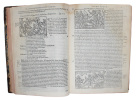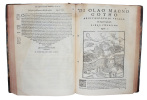5 books for « olaus magnus »Edit
-
Century
16th (2)
20th (2)
21st (2)
-
Topics
History (4)
Scandinavian (2)
-
Countries
Denmark (4)
France (2)
Historia delle Genti et della Natura delle cose settentrionali. Da Olao Magno Gotho Arcivescovo di Upsala nel Regno di Suezia e Gozia, descritta in XXII Libri. Nuoamente tradotta in lingua Toscana. Opera molto diletteuole per le varie & mirabili cose,...
Vinegia (Venice), Apresso i Giunti, 1565. - Colophon: In Veneta, Nella Stamperia di Domenico Nicolini"...de gli heredi di Luc'antonio Giunt, 1565. Folio. (30 x 21 cm.). Bound later (around 1800) in hcalf. Spine divided in 6 compartments, all richly blindtooled and in the middle of each a small gilt rosette. A crack to joint (2 cm.) at upper compartment. Light wear along edges. Marbled endpapers. Red edges. (22),286 leaves. With engraved map (a reproduction in smaller size of ""Carta Marina"") - the map in FACSIMILE, and more than 450 fine woodcut illustrations in the text, the the greatest part measuring 59 x 93 mm, a few half-page and some 1/3-page. Woodcut device on title-page and on colophon-leaf. Title-page mounted and with small closed tears. Title-page slightly soiled. A faint dampstain to upper corners on Index-leaves (""Tavola""), which appears again in more weakened form towards end. A faint dampspot in upper inner margin throughout. The last few leaves with a bit of browning, 2 small holes in last leaf with loss of a few letters.
First Italian edition (and in full), being the second folio-edition as well as the second edition in the vernacular, of Magnus' great work ""Historia de gentibus septentrionalibus"", 1555, which constitutes one of the most important sources on the Northern customs and daily life of the time. The present first Italian edition published 10 years after the first edition, which is in Latin, Rome 1555. A French translation appeared, in 8vo, in 1560-61). In reality, this famous work is a large commentary and notes to Olaus Magnus' own map, the famous ""Carta Marina"", which he published in Venice in 1539, of which only two copies are known. The Carta Marina (""Map of the Sea"" or ""Sea Map""), is the earliest map of the Nordic countries that gives details and place names. Only two earlier maps of Scandinavia are known, those of Jacob Ziegler and Claudius Clavus. The ""Carta Marina"" is reproduced here in smaller size, but in facsimile.The woodcut illustrations and views - here printed with the same woodblocks as the Rome edition of 1555 - are of the greatest importance to the cultural history of the Nordic countries, as they illustrate the religions, folklore, occupations, as well as the geographies, fauna etc. of the Scandinavian people. They have since been reproduced a number of times. The artist is not known, but they are probably carved after sketches by Olaus Magnus himself. Swedish Books 1280-1967, No. 18. - Collijn ""Sveriges Bibliografi intill År 1600"", II: p. 221.
Historia om de Nordiska Folken deras olika Förhållanden och Villkor...
(Stockholm), Gidlunds, (1982). Lille 4to. Opapbd. med smudsomslag. Med gengivelser af de originale træsnit.
Die Wunder des Nordens. Erschlossen von Elena Balzamo & Reinhard Kaiser
Frankfurt am Main, 2006, in-8, 380pp, reliure éditeur, emboitage, Très bel exemplaire. de la bibliothèque d'André Crepin! 380pp
Historia de Gentibus septentrionalibus, earumqve diversis statibus, conditionibus, moribus, ritibus, superstitionibus, disciplinis, excercitiis, regimine, victu, belleis, structuris, instrumentis, ac mineris metallicis, & rebus mirabilibus, necnon uni... - [THE LARGE COMMENTARY TO ""CARTA MARINA""]
Romae, (Colophon: Apud Ioannem Mariam de Viottis Parmensem, in aedibus Birgitttae), 1555. Folio. Bound to style in later (around 1950) full vellum with 4 raised bands to spine. Endpapers renewed. Old owners name on foot of titlepage. 42 unnumb. leaves + 815 pp. (p. 815 is the full page woodengraved printers device, verso blank). With 472 fine woodcuts in the text, the greatest part measuring 59x93 mm, a few half-page and some 1/3-page, among these the full-page map over Scandinavia (the smaller sized ""Carta Marina""). Only few scattered brownspots, probably lightly washed by the rebinding. From ab. p. 500 the upper margins have some faint dampspots, which on ab. 25 leaves has left some small loss of paper, and on a few places the loss of a letter in the caption title, but everywhere professionally repaired with paperpulp where needed.
First edition of Magnus' great work, which constitutes the first larger geographical-ethnographical description of Scandinavia and one of the most important sources on the customs of the Northern peoples and daily life in the 16th century.""Olaus Magnus (1490-1557) was the last Catholic archbishop of Sweden, which he left in 1524. This book is still one of the most importent sources on Northern customs and daily life of the time. The artist of the wood-cuts is unknown but most of them are made after drawings by the author. 13 editions were published in 16th century and several in the following, comprising translations into Dutch, French, German, Italian and lastly into Swedish. The history was intended to expand the information in the large map, ""Carta marina"", which Olaus Magnus published in venice in 1539, and of which only one copy was known, until a second was discovered in 1962 and acquired by the University Library of Upsala."" (Swedish Books 1280-1967, no.18).Collijn 2, pp. 221-7. - Sabin, 43830.In reality, this famous work is a large commentary with notes to Olaus Magnus' famous map, the ""Carta Marina"", which he published in Venice in 1539, of which only two copies are known. The Carta Marina (""Map of the Sea"" or ""Sea Map""), is the earliest map of the Nordic countries that gives details and place names. Only two earlier maps of Scandinavia are known, those of Jacob Ziegler and Claudius Clavus. The ""Carta Marina"" is reproduced here in smaller size.The woodcut illustrations and views are of the greatest importance to the cultural history of the Nordic countries, as they illustrate the religions, folklore, occupations, as well as the geographies, fauna etc. of the Scandinavian people. They have since been reproduced a number of times. The artist is not known, but they are probably carved after sketches by Olaus Magnus himself. Swedish Books 1280-1967, No. 18. - Collijn ""Sveriges Bibliografi intill År 1600"", II: p. 221 ff. - For ""Carta Marina"" see Ginsberg ""The History of the Nordic Map"": 33.
Historia om de Nordiska Folken. I Urval av Knut Hagberg. (Uppsala, 1963).
Orig. helshirt. 201 pp. tekstillustr.
 Write to the booksellers
Write to the booksellers




